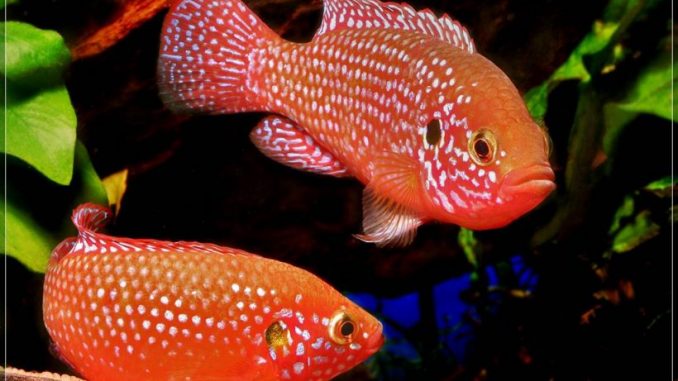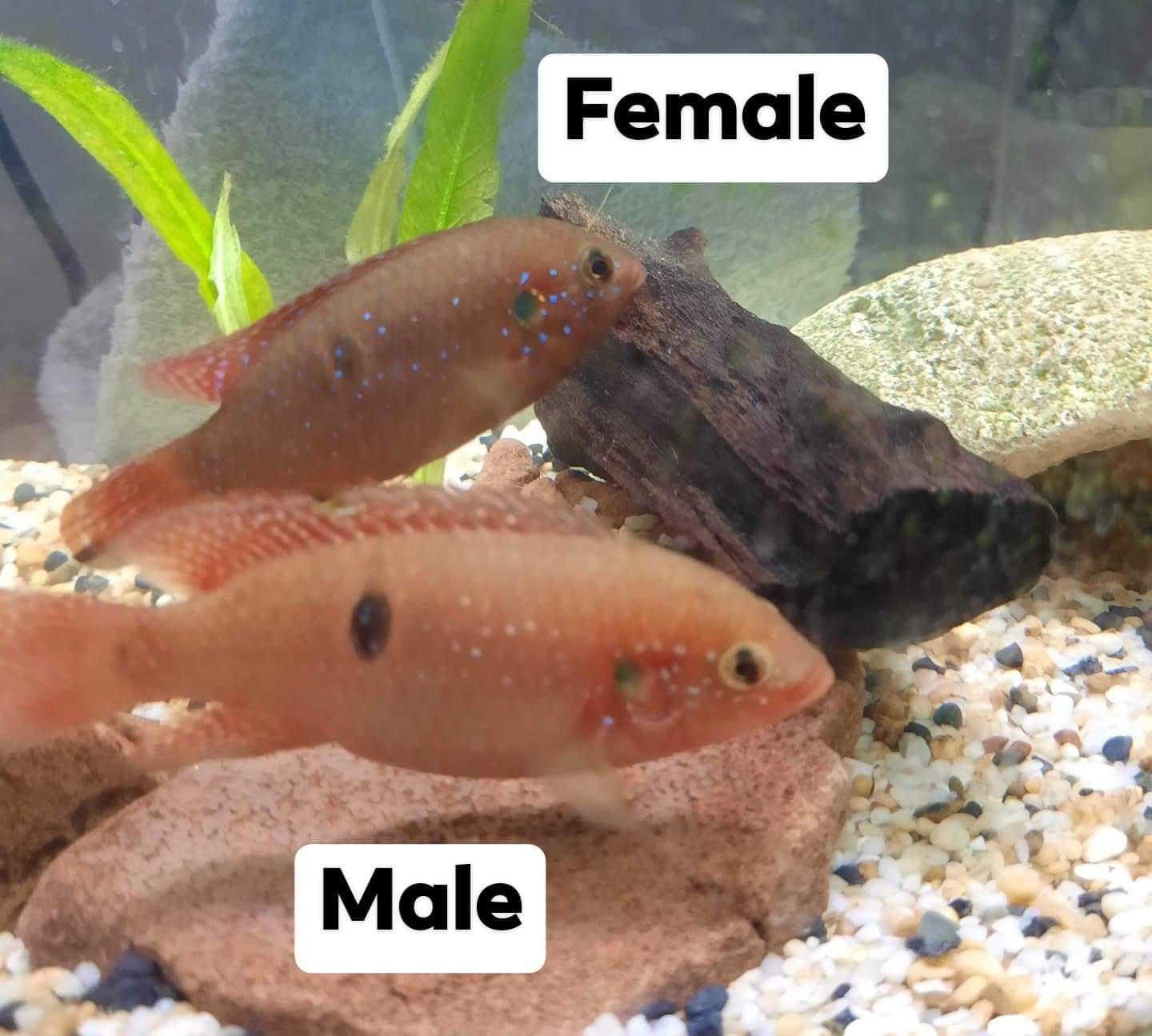
Table of Contents
Species Summary
One of the most spectacular fish in the industry in regards to colouring is the magnificent cichlid, the Red Forest Jewel (Hemichromis lifalili.)
Hemichromis is a genus of fishes from the cichlid family, known in the aquarium trade as jewel cichlids. Jewel cichlids are native to Africa. Within West Africa, Hemichromis species are found in creeks, streams, rivers and lakes with a variety of water qualities including brackish water lagoons.
These cichlids are well known for colouring up to an impressive vibrant red especially evident during breeding and attending to their eggs.
Appearance
Hemichromis lifalili can grow up to 8.2–10 centimetres (3.2–3.9 in) long and are red-orange or bright red with rows of small blue spots all over the body, the head and fins. Two dark spots are present on the sides, the first on the opercle, the second in the middle of the body.
The body of Jewel cichlids is fairly oval and a little pointed at the head. Their dorsal fin starts about a third of the way down their body and continues to right before their caudal fin. Their anal fins are shallow and trim and end exactly as far back as their dorsal fin does.
Their head shape slants upward from their mouth and then curves into the start of their back at a very subtle bump. This bump is usually more pronounced when Jewel cichlid fish are younger.
Red Forest Jewels feature some of the most intense, red colouration that can be seen within any Cichlid species.
Their iridescent green to blue spotting on an bright red base colouration; they also have a black, lateral spot as well as a black, ocellus spot on their operculum.
As juveniles, the species may exhibit a black caudal spot, but it will vanish as the fish matures. Red Forest Jewels have translucent fins with the same colour markings as their bodies and although the females will usually have much brighter colours, the males of the species will grow to be larger.
Natural Habitat
This species is present in The Democratic Republic of the Congo in western Africa, the Lower and Central Congo River basin, except from the Shaba (Katanga) and Kasaï regions where it inhabits still and slow-moving creeks and tributaries. Despite their sluggish nature, these waterways are usually rich in oxygen.
The small streams and canals are often found with overhanging and surface vegetation. The bottoms of these waterways are muddy.
The water temperature in these areas is quite warm water (22–24 °C) with a neutral to slightly acidic water pH.
Tank Setup and Tankmates
Provide a generous sized aquarium (4 foot would be quite adequate) with as many hiding places as possible to help disperse aggresion and provide sanctuary.
This can be achieved through the use of rockwork (arrange to form caves), driftwood and areas of dense planting.
The species tends to dig, so any plants will need to be very strongly rooted, potted or weighted. It’s essential that the water is well-oxygenated – an airstone and airpump is a favorible addition.
We find the best tank mates are non aggressive African cichlids such as Peacocks, Nimbochromis varieties, Red Empress but also they mix well with mildly aggressive American cichlid varieties, catfish, clown loaches, large tetras and even some larger livebearers.
Food and Diet
The Red Forest Jewel is an omnivore and in the wild feed on a mixture of small fish, small crustaceans, algae and plant matter.
In the aquarium they should be fed a variety of foods, such as frozen or freeze-dried brine shrimp, bloodworms, blackworms, flake food, algae and cichlid pellets.
It is best to feed them 60 seconds worth of food a couple of times per day.
Behaviour and Temperament
For the most part Red Forest Jewels are quite a placid easy going fish within an aquarium.
They will however become aggressive when they nest and eventually lay eggs (your fish will need to learn to avoid the area where the eggs are laid to avoid confrontation.)
This is where your aquarium setup may come to help with lots of hidey holes to get away from angry parents defending eggs and fry alike.
Sexing and Breeding Information
Sexing young Red Forest Jewels in a Local Fish Shop situation can be a little tedious. Certainly looking at the behaviour within a group of 20 or so can give you an idea of a more assertive male. Here are some hints…
- Females are a shade darker than males. (see diagram below)
- Males have slightly longer fins, particularly its dorsal fins are slightly more pointed.
- Usually an alfa male will boisterously be front and centre of where fish are fed from ie front of the tank.
- Females are also known to show almost a blackish colour whilst laying their eggs.
- I also find looking over the top of juvenile Red Forest Jewels (ie in a bucket or over the top of an aquarium) a female is a darker colour on top and a male slightly lighter.

Red Forest Jewels are avid breeders – I find they breed every 2 to 4 weeks in an aquarium given the correct conditions.
You will get your first hint that these fish are ready to spawn when two fish become bright red before they locate an area, dig a nest, clean an area with their fins before laying up to 300 eggs.
The eggs will hatch in 2 days and the fry will be relocated to pre-dug pits in the substrate.
Young parents often eat their batches of eggs (perhaps the first 3 to 5 batches of eggs) but they will soon get it right.
The Jewel Cichlid parents generally will look after their fry only until they reach around 1/2 inch in length or perhaps up to 2 to 3 weeks maximum.
In the wild, they then would send the fry out to fend for themselves almost straight away however in a community tank, these 1/2 inch fry are likely to be eaten by larger fish, so you should remove them from their parents and any other fish in their aquarium.
Place them in a tank of their own until they approach adult size and are large enough not to get eaten by the other residents of your aquarium.
Often fish will be forced down one end of the aquarium when breeding happens, try encouraging an area to breed like placing a cave down one corner of the aquarium.
Snapshot Summary
Scientific Name : Hemichromis lifalili
Common Names : Red Forest Jewel, Blood-Red Jewel Cichlid, Red Ruby Cichlid
Care Level : Medium
Size : 10cm (4 inches)
pH : 6.5 – 7.5
Temperature : 24°C – 28°C (76°F – 82°F)
Water Hardness : 3° to 20° dH
Lifespan : 5 years
Origin / Habitat : West Africa Congo
Temperament / Behavior : Peaceful until spawning
Breeding : Egg layers
Aquarium Size : 200 litres minimum
Tank Mates : Catfish, Clown Loaches, Peaceful Cichlids, Larger tetras
Fish Disease : Nothing significant
Diet / Foods : Eat most common aquarium foods. Flakes, frozen, freeze dried and may nibble at some aquarium plants.
Tank Region : Bottom half and middle
